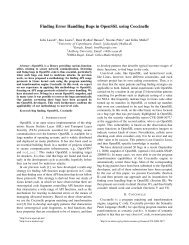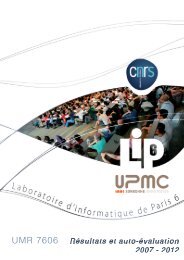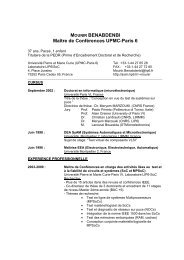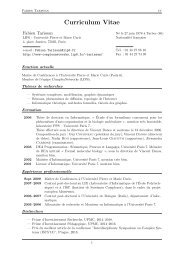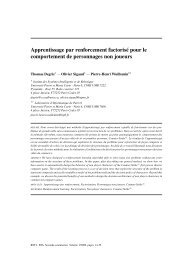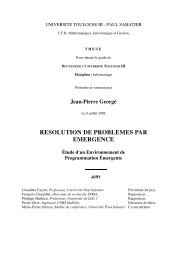Proceedings [PDF] - Measurement and Analysis of P2P Activity ...
Proceedings [PDF] - Measurement and Analysis of P2P Activity ...
Proceedings [PDF] - Measurement and Analysis of P2P Activity ...
Create successful ePaper yourself
Turn your PDF publications into a flip-book with our unique Google optimized e-Paper software.
International Conference Advances in the <strong>Analysis</strong> <strong>of</strong> Online Paedophile <strong>Activity</strong> Paris, France; 2-3 June, 2009<br />
Given the vast amount <strong>of</strong> information that is communicated within online social networks,<br />
new monitoring <strong>and</strong> analysis technologies need to be developed in order to tackle the growing<br />
problem <strong>of</strong> child grooming <strong>and</strong> the distribution <strong>of</strong> child abuse media. The development <strong>of</strong><br />
such technologies faces three significant research challenges:<br />
1. How to identify active child sex <strong>of</strong>fenders across online communities<br />
Paedophiles <strong>and</strong> other child sex <strong>of</strong>fenders <strong>of</strong>ten masquerade as children in order to<br />
establish contact with potential victims <strong>and</strong> gain their trust. Distinguishing the<br />
“innocent” interaction amongst children or amongst children <strong>and</strong> adults from such<br />
predatory advances is a non-trivial task yet effective, early <strong>and</strong> accurate identification<br />
<strong>of</strong> sexual <strong>of</strong>fenders is vital for the protection <strong>of</strong> children. At the same time such<br />
<strong>of</strong>fenders may use multiple online identities <strong>and</strong> known child sex <strong>of</strong>fenders may<br />
move to other online social networks upon detection in one network. It is, therefore,<br />
vital that once a suspected child sex <strong>of</strong>fender is detected in one network, s/he can be<br />
successfully detected in other networks which s/he may attempt to employ for<br />
grooming children.<br />
2. How to identify the core distributors <strong>of</strong> child abuse media<br />
The key research challenge is to accurately identify child abuse media from the<br />
plethora <strong>of</strong> perfectly legal material that exists within file sharing systems. The<br />
problem is compounded by the fact that <strong>of</strong>fenders <strong>of</strong>ten use specialised vocabulary to<br />
describe their shared media—a vocabulary that evolves <strong>and</strong> changes over time—<strong>and</strong><br />
operate over different file sharing networks. Any monitoring framework must be noninvasively<br />
attachable to existing file sharing systems given the wealth <strong>of</strong> such<br />
systems <strong>and</strong> clients available today. In addition to identifying child abuse media<br />
within such systems, any monitoring tools must be able to distinguish core<br />
distributors <strong>of</strong> such media from mere users. This is essential for child protection as<br />
this would help law enforcement agencies in tackling the problem at its roots.<br />
3. How to ensure that such developments maintain ethical practices<br />
The development <strong>of</strong> such monitoring <strong>and</strong> analysis techniques raises a number <strong>of</strong><br />
ethical challenges pertaining, on the one h<strong>and</strong>, to utilising the framework <strong>and</strong> tools in<br />
a beneficial way for child protection <strong>and</strong>, on the other h<strong>and</strong>, the need to protect<br />
innocent users <strong>of</strong> online social networks from the potential <strong>of</strong> falsely being identified<br />
as child sex <strong>of</strong>fenders <strong>and</strong> safeguarding their privacy.<br />
Isis is aiming to tackle the above three challenges by developing novel chat log analysis <strong>and</strong><br />
non-invasive file sharing monitoring techniques based on natural language processing <strong>and</strong><br />
aspect-oriented programming [4] practices respectively. The resulting framework <strong>and</strong> tools<br />
will assist law enforcement agencies while ensuring that they fall within current ethical<br />
bounds—note our goal is not automation but to provide support for detecting potential sexual<br />
<strong>of</strong>fences through analysis <strong>of</strong> large amounts <strong>of</strong> data which cannot manually be analysed in an<br />
efficient manner.<br />
2. Challenges Tackled by the Isis Approach<br />
Existing work on policing online social networks has focused primarily on the monitoring <strong>of</strong><br />
chat <strong>and</strong> file sharing systems. Chat policing s<strong>of</strong>tware for home use such as Spector Pro 2 ,<br />
Crisp 3 <strong>and</strong> SpyAgent 4 allow the logging <strong>of</strong> online conversations, but are restricted in that they<br />
need to be installed on the actual PC that is partaking in the activity. Less obtrusive chat<br />
policing systems, as used by policing organisations, typically use a network-level tracing<br />
methodology [5] to identify <strong>and</strong> log chat traffic at the network-level for later analysis.<br />
2 www.spectors<strong>of</strong>t.com<br />
3 www.protectingeachother.com<br />
4 www.spytech-web.com<br />
34


![Proceedings [PDF] - Measurement and Analysis of P2P Activity ...](https://img.yumpu.com/32964521/34/500x640/proceedings-pdf-measurement-and-analysis-of-p2p-activity-.jpg)

